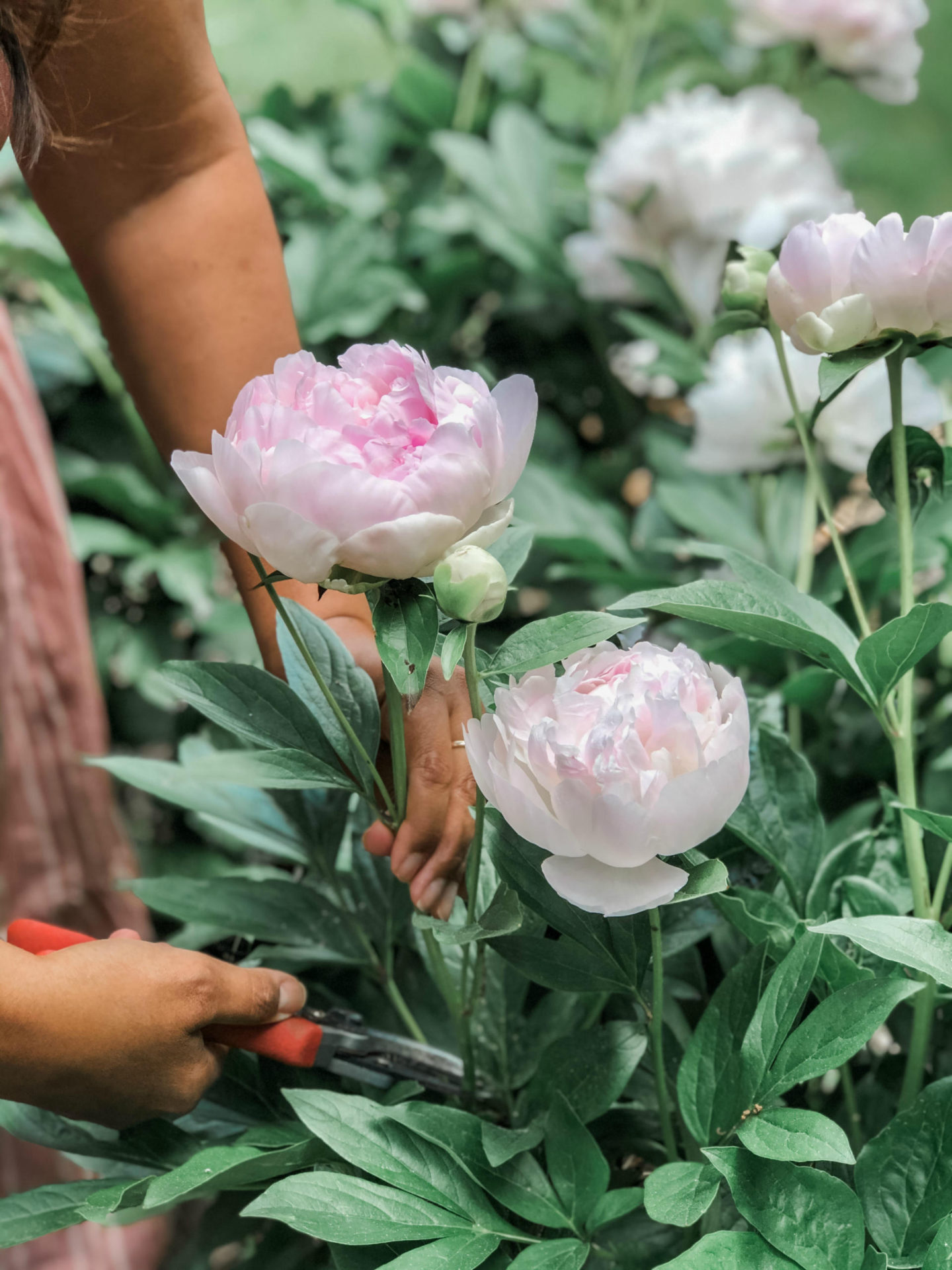Peonies, peonies, the botanical queen of late spring! These beauties steal the show with their luxuriant blooms, feathery foliage and intoxicating fragrance. And depending on the variety, their blooms can sometimes reach the size of your head!

My love of peonies didn’t begin until I fully understood the magic of their blooms. We originally had the gardeners plant four bushes when we built the house and they’ve since grown into beautiful impressive bunches.
I have two varieties planted, this one is called ‘Shirley Temple,’ and the other is ‘Maxima Festiva,’ you can take a peek at them in this recent post. The Maximas are smaller in size with a very faint scent and are absolutely heavenly to display.

The Shirley Temples are by far my favorites because they have the most amazing fragrance. Prized by most gardeners, Peony Shirley Temples are truly fascinating. Besides the delightful fragrance, the flowers open from soft pink buds to large pale-blush pink blossoms with loosely ruffled petals. They slowly turn a soft ivory as they age. In my opinion these are by the prettiest and they are also highly sought after for weddings!

As a cut flower, peonies can last a little over a week in the vase. Many carry a sweet, subtle scent and they’re the most requested flowers for weddings and special events. Unfortunately their season is incredibly brief. You can usually find them at the florists in May and June, but their bloom and harvest time is literally a short couple of weeks.
As gorgeous as these are, peonies are actually very easy to grow. They look beautiful as a landscape plant which is why we have our four bushes in two different islands. Once established, peonies can provide flowers every year for decades with little or no maintenance.

HOW TO GROW PEONIES
There are several types of peonies but we’re keeping it simple and talk about the most common which are the ‘Herbaceous Peonies.’ These grow as bushes that die back to ground level each fall and re-emerge with red-tinged stems in the spring.
1. Peonies take time to mature and you must therefore be patient. While it may be tempting to purchase a small, cheap plant and wait for it to grow, buy a well established peony. One that is at least 3-5 years old is best to make sure of success in your garden.
2. Peonies need a TON of sun. Although many varieties will tolerate some shade, if your peony is in heavy shade it will be reluctant to flower well.
3. Plant your peony in fertile, free-draining soil. They don’t like to sit in water in the winter.
4. Plant peonies in the fall: late September and October in most of the U.S. If you must move a mature plant, fall is the time to do it—specifically, when the plant has gone dormant. Peonies should be settled into place about six weeks before the ground freezes.
5. When planting a container-grown peony, dig no deeper than when it grew in the pot. Water thoroughly at the time of planting.
6. Stake your peonies! Once established, peonies will flower abundantly for years. When they get big, blousy flowerheads (like mine do) the plant will need to be staked! Their blooms can get massive and heavy which tend to fall down (especially during the rainy season) oftentimes breaking or disturbing neighboring blooms.

HOW TO CARE FOR YOUR PEONIES
1. Spare the fertilizer. Work the soil well before you plant, mixing in compost and a little fertilizer, and that should be enough.
2. If your soil is poor, then fertilize (bonemeal, compost, or well-rotted manure) in early summer, after the peonies have bloomed and you have deadheaded the flowers.
3. Cut the foliage to the ground in the fall to avoid any overwintering diseases.
4. Don’t smother peonies with mulch. You can mulch VERY loosely and remove in the spring.If the crown (where the buds are produced) becomes really large, it is recommended that you divide it every few years. Other than that, there isn’t much to do but enjoy the flowers.
5. Peonies are generally very hardy and deer resistant.
6. Ants are your friends! People always wonder why so many ants crawling on the peony buds. Don’t worry, they’re just eating the peony’s nectar. Never spray the ants; they actually help your peonies by attacking any bud-eating pests!
7. Deadhead your peonies. If you are letting some flowers stay on the plant, don’t forget to deadhead. Doing this will allow your plant to send all its energy back to the roots.


HOW AND WHEN TO CUT YOUR PEONIES FOR DISPLAY
You can pick your peonies as open as you like but I prefer to cut them when they’re in the ‘in-between’ stage. This is when the flowers have begun to bloom partially. I also make sure to cut with several buds in the one branch so they can open as the others age, plus they look absolutely darling!
If you pick buds too soon and the petals haven’t fully developed you risk not getting flowers at all. This year I was away and didn’t cut my peonies at the stage I prefer, instead I got to cut them in almost full bloom. That’s not a bad thing, they’re gorgeous regardless, but they tend to not last as long.

There you have it. Most of what you need to know about growing, harvesting and displaying your fabulous peonies. It seems like a lot fo verbiage, but they’re really easy to maintain. I hope you find this article helpful and if you do end up planting one or two, or if you have any suggestions of your own, I’d love to hear about it. Keep me posted with comments below.
Have a great weekend friends!🌸
FUN FACTS:
Marco Polo described peony blossoms as “roses as big as cabbages.”
Peony petals are edible. You can add them to summer salads or use as garnish for lemonade and ice tea.
“Had I but four square feet of ground at my disposal, I would plant a peony in the corner and proceed to worship.” -Alice Harding, THE BOOK OF THE PEONY
“The fattest and most scrumptious of all flowers, a rare fusion of fluff and majesty…” -Henry Mitchell, American Writer (1923-93)
